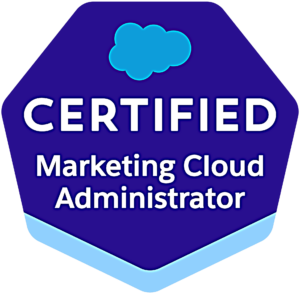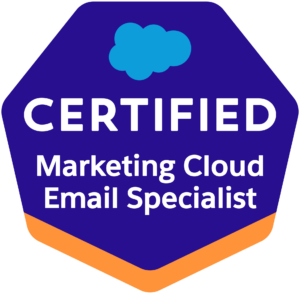Businesses know decisions should be made with data points. So why is it so hard for people to buy-in when facts and numbers are presented? Data helps establish credibility and changes decisions from being subjective to objective, but far too often, it’s pushed aside.
After working with multiple businesses who have lots to little data, and companies who run on gut-feel or data-driven decision making, the issues stem from how data is being communicated. Sensible Marketer Inc has found there are five ways to help sell ideas better, with how numbers and facts are presented.

1. Interpreting data: from a data table to visual queues
Far too often, people put together a presentation where they copy and paste an excel spreadsheet with columns and rows to present, because they feel all the data points can address the questions people will want to dig into. This may be great for a supporting page at the back of a presentation, or to have handy as a reference guide when those financial, sales, or technical minded people want to get into the details; however, putting them at the front in the main discussion area is overwhelming and you can lose control of the conversation. The presenter has had more time to digest the information, while the audience is trying to quickly come up with a conclusion about what they see in 2 minutes. By interpreting and tidying up the data, an audience can be lead to the same conclusion in seconds from visual charts, graphs, and highlights around which numbers are important. Think of this as how people learn – some people need visual queues to reinforce the story, where a slide with over 30 numbers is hard to digest. Visually, less clutter on the page can help people understand the data quicker. Quick tips here include:
– do the math for your audience – translate year-over-year numbers into growth %
– use colour and shapes to draw the eye to where focus is needed
– reduce clutter by rounding numbers – instead of $129,485.60, round to $129K
When putting a presentation together, if there is a chart of raw numbers, question what’s the story that it’s trying to sell and how can it be illustrated. Take a look at point number 4 if you need ideas.
2. Only show data that relates to the main takeaway
In companies where leaders and employees are starved for data, the temptation is to throw all the data you have into your pitch. The thought of adding data means credibility, and the thought is that the more there is, the better, right? Generally, it’s not the case. As an example, if the main take-away is about a 3-year trend that’s increasing, don’t put 5 years worth of data. It sounds simple enough, but it happens a lot. Always look at what the main point and ask if the data supports that take away strongly or not. When in doubt, it most likely needs to be removed or put on a separate slide of its own if it still feels like an important part of the overall story. Presenting too much data will get people lost in the weeds – it’s an added distraction, and it takes much longer for people to agree to what the presenter wants. Keeping it brief, with details that support that main takeaway can allow people to easily see how conclusions were drawn, rather than trying to figure out how the other data comes into play.
3. Guide audiences to the conclusion – don’t leave it open ended
Once when I was helping a family member write a research paper, I remember highlighting that after all the data and facts she reported, she needs to summarize it right after. Her response was “isn’t it obvious what the conclusion is?” The answer is ‘no.’ Time and time again, this comes up quite often where employees present data, but don’t get to the ‘so what.’ They expect that they’ve presented a strong case, and that the audience should arrive to the same conclusion. The problem here is that not everyone comes from the same reference point, nor have they had the same amount of time to study the matter. When presentations are expected to help reach a consensus within an hour, guiding the audience to the conclusion is the best approach. Whether it’s a kicker box at the bottom of every slide, ensure the question of “so what” has been answered and is written with every piece of data. An example came up when looking at national trends for a company. The data presented showcased 5 years worth of data, across multiple provinces. It was a large table, without summary or highlights. When presented, the team took completely different interpretations, as people were looking at the last 3 years instead of 5, some looking year over year, some looking by province. Too much data causes an audience to have their own ideas, which takes up value time in selling your idea. In many cases, people can’t get through a presentation cause they’re having to get the audience on the same page and address questions, leading to additional follow up and confusion.
4. Choosing the right visual – say ‘no’ to pie
Whenever people put together data, most often they turn it into a pie chart. I love pie, but those who know me know that it hurts my heart when I see those in a presentation. Pie charts are very flat, and don’t show the data in a way that can be easily interpreted. For example, two pie charts would be needed to show a year over year change in distribution of a client base. Visually, I have to continue looking back and fourth to try and figure out where a lot of the changes are. Using a distributed bar graph, or a line graph, or anything other, can help my visually capture quickly the differences at a glance, and see trends easier. A book that was once given to me in my telecommunication days is called “Say It With Charts” by Gene Zelazny. There, you can find multiple types of graphs and visuals, and how they support the story you need to tell. It’s a great reference source. Many of the big consulting firms prohibit the use of pie charts, as it is not a strong way to get a message across. If charts aren’t working, also look to iconography. With infographics becoming popular, icons are available in most programs and are a great way to call out the values that need to be highlighted. Remind yourself of the story you’re trying to tell, and try different visual treatments to help people see the story before reading the numbers.
5. The rule of 80%
In every business I’ve been in, data integrity is always an issue. I personally learned that unless you’re reporting information to the street in financial numbers, there’s no need to be exact in marketing. I had the experience where I was presenting numbers, and trying to present the data as unbiased as possible, I’d share caveats of “but there’s 10% possibility of X…” or “there’s a small chance that the data…” Following that presentation, my VP pulled me aside and told me I needed to stop doing that. I thought I was being very honest and accurate about my data, what she told me was that I was openly encouraging people to question and discredit my data. Many leaders and business people know that data isn’t going to be 100% correct. So If you the data is telling about 80% of the story correctly, there’s no need to share all the other issues that could come into play. It’s good to have those back-pocket should it come up but presenting data requires confidence to help win-over any audience.
What has worked for you? Share your thoughts, questions or tips you may have from your experience on how to present data.
Sensible Marketer Inc is a marketing consulting firm working with startups to enterprises, to better use customer insights in marketing, advertising and decision-making practices. If you need help with your content strategy and development, we’re here to help.
Contact us today for a coffee chat to discuss how we can work together.



